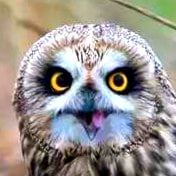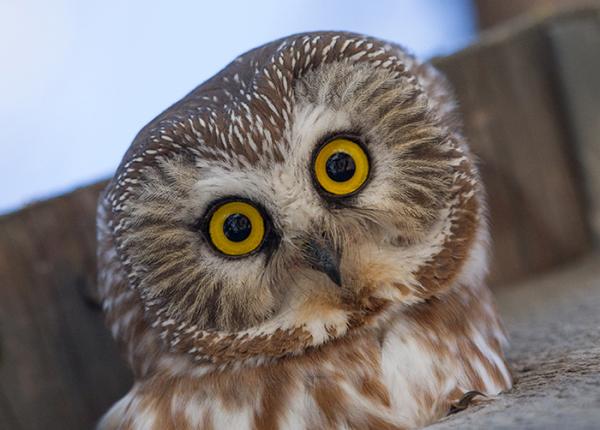I won’t get into a stand-off with this fella!
Don’t let it trick you into a staring contest either! 🤨
Hang on a tick! I was told that owls can directly control their talons, and can only grasp by collapsing their legs and only release by extending them. How is this one grasping with extended legs??
You like to pose some real challenging questions for me! I will give you my best. 😅
I wasn’t sure how detailed an answer I was going to get on this. Once we get into the finer details, the writing becomes a bit hard to both find, and for me to comprehend!
It’s a bit unhelpful no real context was provided on this photo. The owl, to me, looks to be leaning a bit to its left, so I’m wondering if this is a photo of it mid-takeoff. It could be in the process of breaking its grip purposefully there.
I was able to find some more specific anatomy that could also account for gravity doing some of the work for those toe tendons.
From AvesBiology.com
The raptor digital tendon locking mechanism – Digital tendons form a mechanical-locking mechanism in many birds that must maintain a degree of grip force, including perching, hanging, tree-climbing, and raptorial species. In raptors, powerful hindlimb muscles produce a strong grasp, and a tendon locking mechanism (TLM) helps sustain grip force. The components of the digital TLM include a ‘textured’ pad on the ventral surface of each flexor tendon that contains thousands of minute, rigid, well-defined projections called tubercles (see figure below). The neighboring portion of the surrounding tendon sheath contains a series of transversely running plicae (folds) that often have a proximal slant (i.e. towards the base of the toe). When the flexor tendons are pulled taut, and the digits flexed, the tubercle pad moves proximally over the stationary plicae on the sheath. When resistance to digital flexion is met, the locking elements intermesh and engage and the friction produced prevents slippage of the tendons. This permits digital flexion to be maintained with little or no muscular involvement (Einoder and Richardson 2006).

Action of the avian digital TLM: Top, digital extension, Bottom, digital flexion. This shows the movement of the talon, flexor and extensor tendons, and the movement of the ventrally located tubercle pad relative to the stationary plicated sheath and phalangeal bone (From: Einoder and Richardson 2006).
So there seems to be an anti-slip mechanism to help maintain a lock of the grip even when the muscles are not flexed temporarily. This would still help keep a grip on prey, for instance, even if they need to flex their leg during a struggle. As long as pressure is on their equivilent of a paw pad, there is still some involuntary locking of the talons.
So I’m not 100% on if all that is what’s going on, but that is my hypothesis on the whole situation. The tendon lock is something I had never heard of before, but it’s a pretty ingenious way to help them maintain grip in a variety of situations.
Now that’s interesting. The previous diagrams I’ve seen implied that the tendons produced all of the force: extended, open; collapsed, closed. This is clear they have more control over it than just leg extension.
Iiiinteresting.
This is the first I had heard of it as well. I never think about their actual feet since there looks to be so little there. That video Fugly shared though looks really great though, and the guy did a great job of talking how a raptor leg works as a whole to generate so much power and grip.
There is no end to the cool features some of these birds have! 😮
So, Owls do have the ability to lock off their talons so that they’re not constantly having to grip things. The tendons for their talons are whonky and have bumpy-things that match with groves in a rigid sheath; which works like a ratchet.
You know those telescoping tubes that lock into place because one side has a spring-loaded button or post, and the other has a pipe? kinda the same thing. The tendon itself runs up their legs to their leg muscles, and it’s relaxed/released by extending their legs.
Here is a video that goes into some detail on it. It’s talking about falcons, but owls have the same kinds of talons, and they do talk about eagle owls.
Oh, I’m glad I saw this when I came to read sxan’s reply! I quick watched the explanation in the beginning and the owl part, but I’m going to watch the full thing when I get a chance. He seemed to have a ton of great info, and I like getting to see the differences between the various types of raptors. Awesome find!
“with most birds you’re worried about getting bitten. yeah. No. they can do that, but, check out these [brutal efficient killing machines]!”




